| Sustainable
use of wood products Although
the division in forestry terminology
between "minor" and
"major" forest products
reflects the bias of foresters managing
forests for timber, the slow growth rates
of forest hardwoods still makes
"major forest products" a
useful category, particularly where the
same species is used for different
purposes in different age classes.
As discussed above (page 13), forest
use differs greatly from the use of low
species diversity, highly productive
vegetation types such as Phragmites
wetlands or Cymbopogon thatch-grass,
where harvesting is seasonal and easy to
manage, with obvious clear cutting of
suitable stands.
Bwindi Forest is at the opposite end
of the scale. Instead of the 1-year
rotation applied in reed cutting
(Cunningham, 1985), sustainable
harvesting of forest for timber aims at a
rotation of 100 years (Leggatt and
Osmaston, 1961). Tree growth rates are
slow, so unlike reeds which regrow from
an underground rhizome within a year, the
time between final harvesting and
replacement of mature trees is seldom
less than 50 years, and often as much as
200 years (for oak trees in Europe for
example).
On the basis of growth measurements
from Afromontane tree species in southern
Africa, Stapleton (1955) considered that
under natural conditions, growth time to
marketable maturity for timber production
from Podocarpus latifolius was 230 years,
Ocotea bullata 220 years and Olea
laurifolia, 200 years.
Logging, particularly when mechanized,
affects mature forest, changing forest
structure and species composition,
resulting from canopy gap formation
(Howard, 1991). In addition to
differences caused by topography and soil
type, logging results in patchy
distribution of both species and size
class categories of trees and shrubs used
for bellows, building poles, beer boats
or bean stakes. It also influences the
availability of these resources, either
increasing the number of young saplings
(bean stakes, building poles) or
colonizing species in disturbed sites
(e.g. Polyscias fulva, Maesopsis eminii),
or decreasing stocks of large hardwoods
due to over-exploitation and competing
uses for timber.
Competing uses
This situation is complicated further
through competing uses for young trees or
saplings of the same species,
particularly as Bwindi Impenetrable
Forest is the most heavily pitsawn of all
principal forests in Uganda.
To foresters, whose objective is
hardwood timber production, saplings of
"reserved species" (Table 14,
page 41) represent regenerating timber
trees. To people from local rural
communities they also represent an
important source of beer boats (>50 cm
dbh), building material (5-15 cm dbh) or
bean poles (1.5-5 cm dbh), with high
density wood favoured due to greater
resistance to borer attack or fungal
infection.
| Table
14. Competing use of forest tree
and shrub species in successive
age/size classes for pitsawn
timber (>50 cm dbh), beer
boats (>50 cm dbh), building
poles (5 - 15 cm dbh) and bean
stakes (1.5 - 5 cm dbh) in Bwindi
forest. |
| Plant species |
Rukiga name |
Life form |
Pitsawn |
Beer boats |
Building poles |
Bean stakes |
| Alangium chinense |
omukofe |
tree |
*** |
|
* |
* |
| Albizia gummifera |
omushebeya |
tree (SF) |
|
|
* |
* |
| Alchornea hirtella |
ekizogwa |
shrub |
|
|
* |
*** |
| Arundinaria alpina |
omugano |
bamboo |
|
|
* |
*** |
| Baphiopsis parviflora
|
omunyashandu |
tree |
|
|
*** |
* |
| Beilschmiedia
ugandensis |
omuchoyo |
tree |
|
|
* |
|
| Bridelia micrantha |
omujimbu |
tree (SF) |
|
|
*** |
* |
| Carapa grandiflora |
omuruguya |
tree |
|
|
* |
* |
| Chrysophyllum
gorungosanum |
omushoyo |
tree (CP) |
*** |
|
* |
* |
| Croton megalocarpus |
omuvune |
tree (SF) |
|
|
* |
* |
| Cyathea manniana |
omungunza |
tree fern |
|
|
*** |
|
| Dichaetanthera
corymbosa |
ekinishwe |
tree |
|
|
* |
|
| Drypetes gerrardii |
omushabarara |
tree |
|
|
*** |
* |
| Drypetes gerrardii |
omushabarara |
tree |
|
|
*** |
* |
| Entandrophragma
excelsum |
omuyovi |
tree (CP) |
*** |
* |
* |
|
| Faurea saligna |
omulengere |
tree (SF) |
*** |
|
* |
|
| Ficalhoa laurifolia |
omuvumaga |
tree |
*** |
|
|
*** |
| Ficus sur |
omulehe |
tree |
|
*** |
|
|
| Ficus spp. (F. ovata,
etc.) |
ekyitoma |
tree |
|
*** |
|
|
| Galiniera saxifraga |
omulanyoni |
shrub |
|
|
* |
*** |
| Harungana
madagascariensis |
omunyananga |
tree (SF) |
|
|
*** |
* |
| Macaranga
kilimandscharica |
omurara |
tree |
|
|
* |
* |
| Maesa lanceolata |
omuhanga |
shrub |
|
|
*** |
* |
| Maesopsis eminii |
omuguruka |
tree (SF) |
*** |
|
*** |
|
| Markhamia lutea |
omusavu |
tree (SF) |
|
* |
*** |
* |
| Newtonia buchananii |
omutoyo |
tree (CP) |
*** |
*** |
* |
|
| Ocotea usambarensis |
omwiha |
tree (CP) |
*** |
|
*** |
* |
| Oxyanthus
subpunctatus |
? |
shrub |
|
|
|
*** |
| Parinari excelsa |
omushamba |
tree |
*** |
|
|
|
| Podocarpus latifolius
|
omufu |
tree |
*** |
|
* |
*** |
| Prunus africana |
omumba |
tree (CP) |
*** |
*** |
*** |
|
| Psychotria
schweinfurthii |
omutegashali |
shrub |
|
|
|
*** |
| Sapium ellipticum |
omushasha |
tree (CP) |
* |
*** |
* |
* |
| Strombosia scheffleri
|
omuhika |
tree (CP) |
*** |
|
*** |
* |
| Symphonia globulifera
|
omusisi |
tree (CP) |
*** |
|
* |
* |
| Syzygium guineense |
omugote |
tree |
|
|
*** |
|
| Tabernaemontana
holstii |
kinyamagozi |
tree (SF) |
|
*** |
|
|
| Tabernaemontana sp. |
kinyamate |
tree (SF) |
|
|
*** |
|
| Zanthoxylum gilletii |
omulemankobe |
tree (CP) |
*** |
|
* |
|
| indet. |
omukarati |
tree |
|
|
*** |
|
|
| Note: Canopy tree species are
marked (CP) and secondary forest
species (SF); *** high
preference, ** acceptable, * used
occasionally. |
For this reason,
despite their "reserved
status", hardwood trees such as
Newtonia buchananii (omutoyo) and Prunus
africana (omumba) are, and probably
always have been, favoured for beer
boats, and Ocotea usambarensis (omwiha)
for building poles.
Cutting of bean stakes is selective
for size rather than species, but if
saplings of canopy species fit into this
category, then they are cut (e.g. cutting
of Strombosia scheffleri (omuhika) and
Ocotea usambarensis (omwiha) in secondary
forest during this survey). Not only are
these species a useful resource to local
people, they also represent the future
forest canopy of the next century.
Trees with low density wood or small
shrubby species are not generally subject
to such competing uses, however. Examples
are:
- Low density timber species used
for beer boats but not for timber
or building poles (such as large
Ficus species such as Ficus sur
(omulehe) and F. ovata
(ekyitoma));
- Secondary forest colonizers
Polyscias fulva (omungo) and
occasionally Musanga leo- errerae
(omutunda) used for blacksmiths'
bellows but not for other uses
due to the soft wood.
- Bean poles cut from understorey
shrubs such as Psychotria
schweinfurthii (omutegashali),
but not for timber or beer boats,
and rarely for building poles.
Wood
requirements and supplies
In terms of supply and demand for
fuelwood and building poles, the
situation in the DTC area is similar to
that described by Howard (1991) for the
Bwamba and Bajonjo counties in western
Uganda, north-east of Bwindi Impenetrable
National Park. Population densities are
high, and land-holdings in intensively
cultivated landscape are similar - 0.2 ha
per person in the DTC area (Kanongo,
1991); 0.26 and 0.19 ha per person
respectively in Bwamba and Bakonjo
counties (Howard, 1991).
In Bwamba, Howard (1991) calculated
that the 121,600 people (17,000
households) would require about 151,000
m³ of fuelwood and 4600m³ building
poles every year (on the basis of a
fuelwood consumption rate of 1.24 m³ per
person per yr and a building pole
requirement of 0.27 m³ per household per
yr or 0.038 m³ per person per yr). The
DTC area is occupied by a similar number
of people (over 99,000 people, 19,000
households).
This situation has been worsened by
the rapid clearing and burning of
indigenous forest for agriculture outside
Bwindi Impenetrable National Park. In
1954, approximately 120 km² of forest
remained in the DTC area within a 15 km
radius outside the Bwindi Forest
boundary. By 1972 this had been reduced
to 42 km² of forest, and by 1983, less
than 20 km² remained (Butynski, 1984).
Now, apart from forest patches in less
densely populated parishes such as Nteko,
virtually nothing remains.
Removal of forest outside of Bwindi
Impenetrable National Park has reduced
supplies not only of fuelwood and
building poles, as Howard (1991) points
out, but also of natural forest as a
source of bean stakes, which although
relatively small in diameter are needed
in vast quantity, and beer boats, which
although required in smaller numbers are
large trees, some of which are species
already over-exploited by pitsawyers
(Newtonia, Prunus) or which are
"keystone species" favoured by
frugivorous birds and primates (Ficus,
Prunus). Through this process, the
national park has become a focal point of
harvesting pressure.
Wood resources
availability
For beer boats large
trees are used (usually >50 cm dbh),
and most beer boats are greater than 40
cm in diameter (see Figure 4). Density of
large trees suitable for beer boats is
low in the multiple-use area, judging
from field observation, and a 1 ha plot
carried out in an Allanblackia - Syzygium
guineense dominated forest site selected
as representative of the forest. This had
a high number of beer boats per ha, due
to the flat terrain and absence of any
pitsawing activity there in the past.
Despite this, only 3 (2.6%) of the 114
trees >30 cm dbh (or 4.6% of the trees
>50 cm dbh) were suitable for beer
boats. With the exception of moist sites
with a high density of Ficus trees,
pitsawn sites would be expected to have
an even lower density of potential beer
boats. Growth rates of most tree species
favoured for beer boats are unknown for
this area. It is likely, however, that
Ficus sur and Ficus ovata would be
expected to reach the minimum tree
diameter (50 cm dbh) suitable for beer
boats in 20-30 yr, and Prunus africana or
Newtonia buchananii in 40-50 yr, both of
which greatly exceed the average
life-span of most beer boats (9 yr). With
improved road networks and urbanization,
marketing of banana beer, and therefore
demand for beer boats can be expected to
increase.
Building poles come
from trees intermediate in size between
those used for bean stakes and beer
boats. Resource assessments evaluating
trees within 20 x 20 m plots for
suitability for building purposes on the
basis of durability, diameter and
straightness, showed that there were
fewer building poles per ha (Figure 8)
than resource users anticipated from
visual assessments made before
quantitative work was done. Visual
assessments of resource availability made
with local people reported in Scott
(1992) therefore need to be considered
with caution.
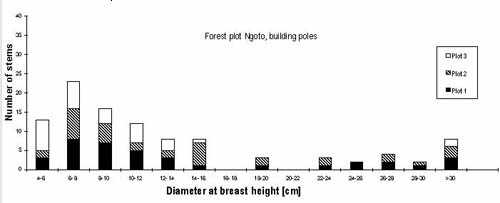 |
 |
| Figure
8.
Combined number of tree stems in
2 cm size-class intervals for
four and three 20 x 20 m plots
(combined total of 0.28 ha) in
secondary forest in the Ishasha
gorge and Ngoto swamp areas
respectively, showing the number
of stems in the size-class range
preferred for building purposes
(5-15 cm dbh). |
| |
In the seven plots
surveyed, only 20.8% (8.3) poles per plot
were classed as very good for building
poles and 52.7% (21) poles per plot were
accepted (see Figure 5, page 35).
Although additional plots are required,
in the absence of other data this would
indicate an average density of 207 very
good poles per ha, or a total of 525
useable poles per ha.
Building pole cutting was not
widespread, and despite the big demand
for poles, high intensity harvesting was
limited to a few patches in secondary
forest. This is attributed to the
widespread cultivation of Eucalyptus and
black wattle, and the less
labour-intensive harvesting from these
cultivated tree species.
Counts in 20 x 20m plots in fields of
climbing beans in the Rubuguli and Nteko
areas during this survey showed that
there were 48,000-52,000 bean
stakes per ha of climbing beans.
By comparison, two forest plots in
Alchornea hirtella (ekizogwa) dominated
forest understorey favoured for bean
stakes (and the highest density of plots
sampled) (Figure 9, page 44), contained
479-630 per 20 x 20m plot, or
approximately 12,000-16,000 bean stakes
per ha, less than half as many as are
required for climbing bean cultivation.
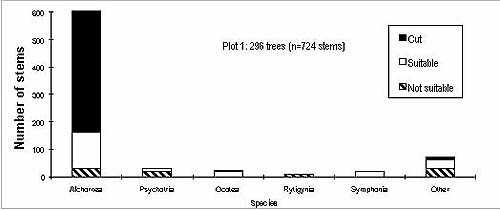 |
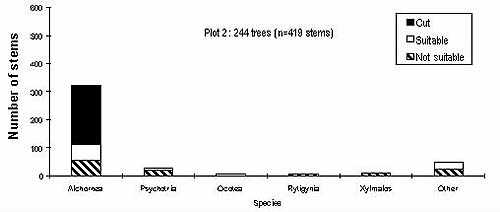 |
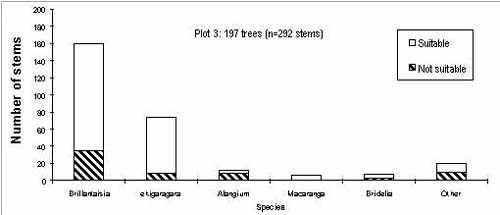 |
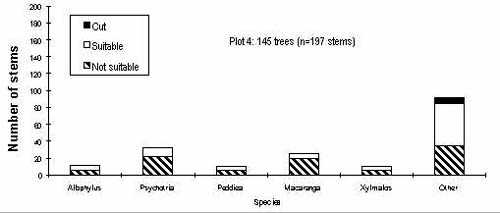 |
| Figure
9. Data
from four 20 x 20m plots in
secondary forest in the Rushaga
area, showing selectivity and
high proportion of stems cut for
bean stakes in Alchornea hirtella
(ekizogwa) dominated understorey
(Plots 1 and 2), and low degree
of harvesting in less favoured
sites (Plots 3 and 4). |
| |
Bean stakes last 2-3
seasons, and beans are a major crop in
the Rubuguli, Nteko, Rushaga, Nteko and
Nyamabale areas. Total demand for bean
stakes in the DTC must represent millions
of saplings per year.
Two additional points are significant
here. First, distribution of Alchornea
hirtella dominated stands is patchy, and
density of bean poles in the surrounding
areas is significantly lower (3000-6000
bean stakes per ha). Second, the
Alchornea hirtella patches are already
heavily utilized, with 58% (429) of stems
cut in the plot with the highest density
of bean stakes, and 35% (186) of stems
cut in the adjacent, lower density plot .
Cultivation of
wood resources
Shortages of fuelwood, building poles
and bean stakes are being experienced in
the DTC area, and a shortage of large
trees for beer boats can be expected in
the future. Reasons for wood scarcity,
and solutions to the problem are
recognized by local people.
Trees (particularly Eucalyptus) are
planted in the DTC area, mainly for
building poles, but are inadequate to
meet either the existing or the future
demand (Table 15, page 45). The need for
building poles was also the main reason
for tree planting in Bwamba, but it was
considered to provide only 328 m³ of the
total annual demand of the 151,000 m³ of
fuelwood, 4600 m³ of building poles and
annual increase in demand for timber of
5280 m³. It is likely that a similar
situation exists in the DTC project area.
| Table
15. Attitudes and approaches to
tree planting in the DTC area
(from data in Kanongo, 1990). |
| Reasons for
planting(n = 115) |
Species planted (n =
120) |
Source of seedlings
(n = 120) |
Species preferred for
building (n = 120) |
Planting site(n =
120) |
| Building (73) |
Eucalyptus (92) |
Own seedlings (89) |
Eucalyptus (106) |
Uncultivated land
(98) |
| Fuelwood (28) |
Acacia mearnsii (46) |
Forest dept. (33) |
Acacia mearnsii (59) |
House compound (49) |
| Sale (5) |
Cupressus (43) |
Community nursery
(13) |
Cupressus (14) |
Boundaries (47) |
| Other (9) |
Markhamia (5) |
Other (8) |
Markhamia (10) |
Among crops (34) |
| |
Sesbania (5) |
|
Other (9) |
In pasture (29) |
| |
Other (2) |
|
|
Fallow lands (19) |
| |
|
|
|
Other (roadsides) (4) |
|
Elephant grass
(Pennisetum purpureum) and trees
(particularly Eucalyptus) are also
planted for bean stakes, while Ficus
cuttings are planted for beer boats
(recorded in the Ngoto area) and canoes
(Lake Bunyonyi). In some areas, even
hardwood timber trees have been planted,
with Entandrophragma (omuyovi) reaching a
dbh of 90 cm within 40 years (Photos 21
and 22, page 45). Such local initiatives
need to be recognized and encouraged.
 |
|
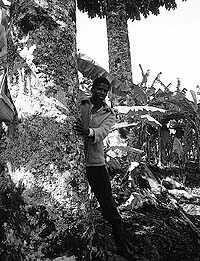 |
| Photo 21. Mr. K.
Byarugaba, second generation
Entandro-phragma (omuyovi)
planter with one of six 1 year
old trees at his homestead in the
Ngoto area . |
|
Photo 22.
Entandrophragma excelsum
(omuyovi) planted in 1950 at the
same homestead by the late father
of Mr. K. Byarugaba. |
| |
|
|
| Box
6. Recommendations for wood use *
Tree planting outside forest
reserves should be undertaken as
an urgent priority, as
recommended by Butynski (1984),
Hamilton (1984), Struhsaker
(1987) and Howard (1991). The
existing single line of Cupressus
that marks the boundary of Bwindi
Impenetrable National Park needs
to be paralleled by planting a
strip of fast-growing exotic or
indigenous trees useful both for
building purposes and fuelwood.
* Initiatives already taken by
local farmers in tree cultivation
need to be supported through
greater supply of seedlings and
the establishment of nurseries.
DTC staff are already involved
with an agroforestry programme.
In addition to work underway,
critical areas with high
population densities, little
woody cover and steep slopes need
to be identified and become a
priority, as short-term rotation
crop production on steep slopes
is unlikely to be sustainable due
to high soil losses.
* Cultivation of bamboo and
elephant grass (Pennisetum
purpureum) should be encouraged
as a soil conservation measure on
bunds and in water-courses, as
well as to provide building
material and bean stakes.
* Subject to further
investigation, wood carvers in
parishes within the DTC area
could be registered and involved
in a rotational management system
for carving of household utensils
(e.g. Rapanea melanophloeos for
carved walking sticks).
* Felling of Polyscias fulva
trees for making blacksmiths'
bellows should be permitted
within multiple-use zones.
* CARE/DTC-Uganda also need to
promote the cultivation of trees
suitable for grinding mortars and
carving (e.g. Markhamia lutea,
Rapanea melanophloeos), and
investigate the viability of
introducing appropriate
technology mills for millet and
groundnuts as an alternative to
hardwood mortars.
* No felling of trees for beer
boats, building poles or bean
stakes should be allowed in
multiple-use areas.
* Attention should be focused
on providing alternative sources
of fuelwood outside the forest,
recognizing that the use of
dead-wood from multiple-use zones
can only meet a fraction of local
needs, and that staff capacity
for multiple-use management is
limited.
*Involve community leaders
from Resistance Council (RC)-1
level (village level) upwards in
tree planting, inducing people to
plant a target number of trees
per year.
* Brick-makers, potters and
waragi makers should be
encouraged to plant a greater
number of trees to balance the
higher fuel consumption rates of
these activities.
* Forest destroyed by arson
should be closed to any
utilization for fuelwood or
building poles. Both fallen and
standing trees play an important
role in preventing soil loss on
steep slopes and also in trapping
seeds, as well as providing
perches for birds dispersing seed
into disturbed sites. The use of
wood for fuel could also provide
an incentive to burn the forest
more regularly if wood shortages
increase, instead of planting
trees as an alternative supply.
* Recommendations for
additions of land adjacent to the
Bwindi Impenetrable National Park
should be followed through as
soon as possible, even if zoned
as part of multiple-use areas.
Critical sites are the Kitahurira
corridor, which needs to be
widened through becoming the
focus of tree planting activity
and Ngoto Swamp, where a strip of
land at least 50 m wide around
the swamp needs to be negotiated
for tree planting. All uses of
plants from the Cyperus papyrus
(efundjo) swamp should be allowed
to continue. Ficus trees should
be planted around the swamp from
cuttings as a source of beer
boats in the future.
* Although exotic tree species
are commonly planted and are
extremely useful, some indigenous
species also have potential for
fulfilling local needs, and are
worth considering. Maesopsis
eminii, Harungana
madagascariensis, Maesa
lanceolata, Dodonaea viscosa,
Trema orientalis, Millettia dura
and M. lutea for example, all
grow well in disturbed sites,
have many uses (such as building)
and are suited to local
conditions. The exceptional
coppicing ability of Alchornea
hirtella makes it a good
candidate for managed coppice
rotations in private woodlots.
|
|